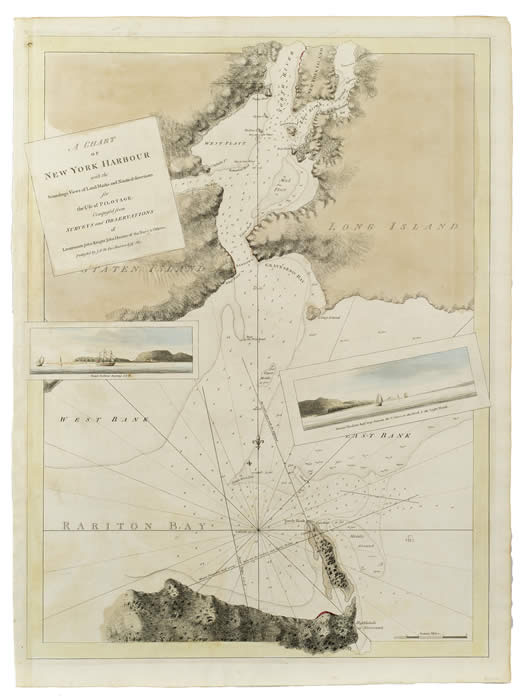Page by Page Guide
Register/Log In
My Bookshelf
My Lightbox
Documents
Overview and Browsing
Document Details Page
Download Options, Saving, Rotating and Printing
Viewing the Original Image
Share
Search Directories
Explore Archive Folders
Basic Search
Boolean Functionality
Advanced Search
Search Results
Viewing Search Results
Visual Resources
Visual Galleries
Chronology
History of America in 100 Documents
Mapping Gettysburg
Thematic Guides
Essays
External Links
Popular Searches
Archive Explorer
RefWorks/EndNote
OpenURL
Getting Started
Before beginning to use American History, 1493-1945, users may find it helpful to consult the background information contained in the ‘Nature and Scope' pages found in the 'Introduction' section of this website. Click on the icon on the right-hand side of the top banner of every page to link to the relevant section of these help pages.
Browsers
American History, 1493-1945 is optimised to use the following browsers: Internet Explorer 9 and above, and the latest releases of Firefox, Safari and Google Chrome. The interactive chronology is optimised for IE9 and above and the latest releases of Firefox, Safari and Google Chrome.
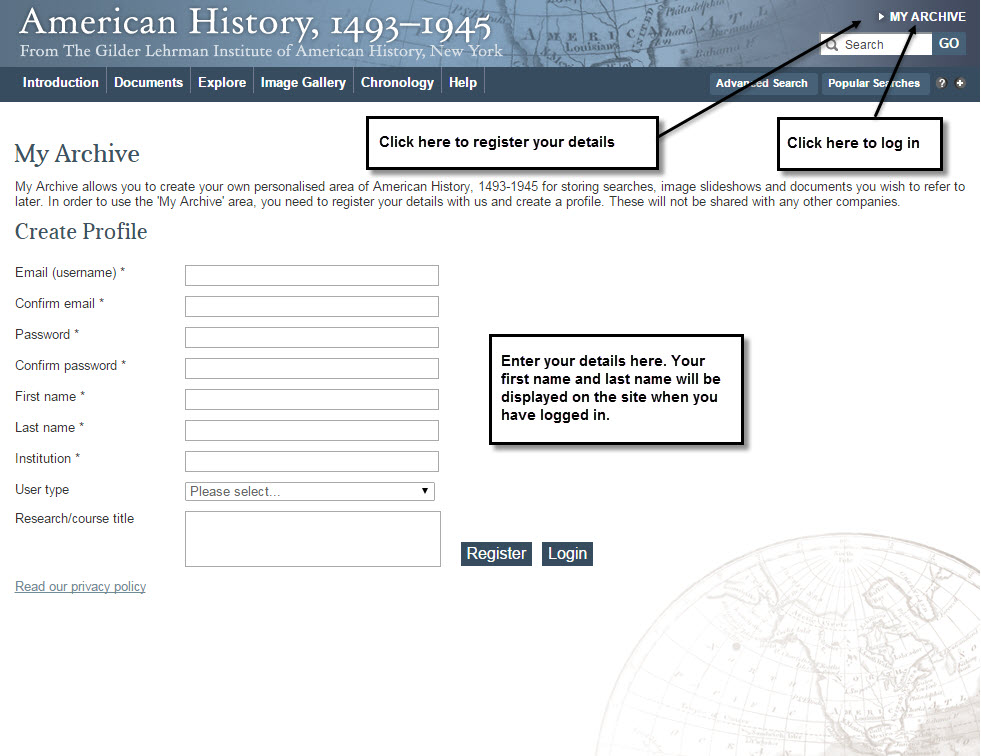
Register/Log In
My Archive enables users to register login details and benefit from a range of bespoke features that allow you to create your own personalised collection. Signing up is easy. Just click on the Register link, submit your login details and off you go.
Adding material to My Archive
Once you've logged in, you will be able to:
- Save selected documents to My Bookshelf
- Save any image from the collection to My Lightbox
- Run a slideshow of your lightbox images
- Save your search results
Every document, search result and individual image in American History, 1493-1945 is tagged with the relevant 'Add to My Archive' button. To return to any document without the need to browse or search every time, simply click on the add button and it will automatically be stored in your individual account so you can return to it at any time.
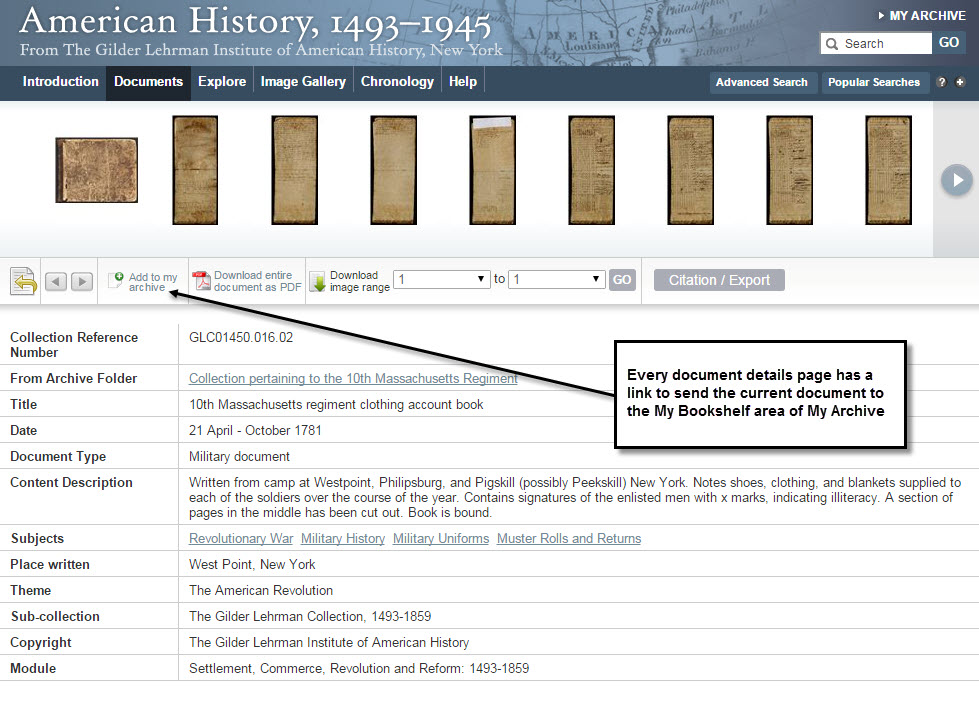
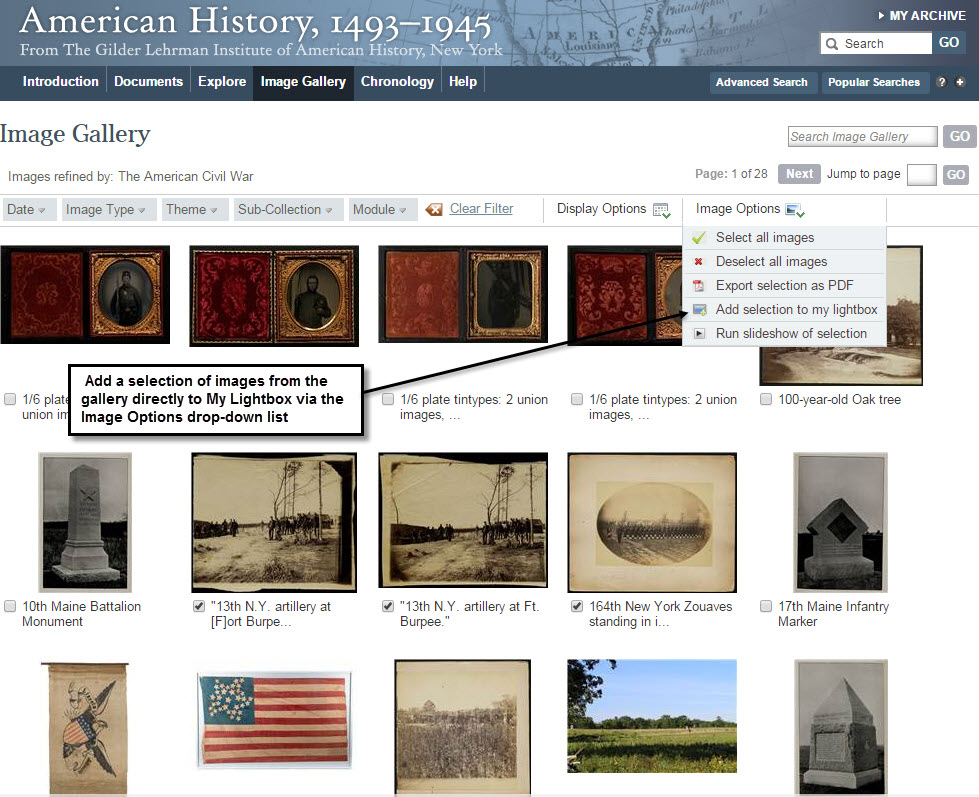
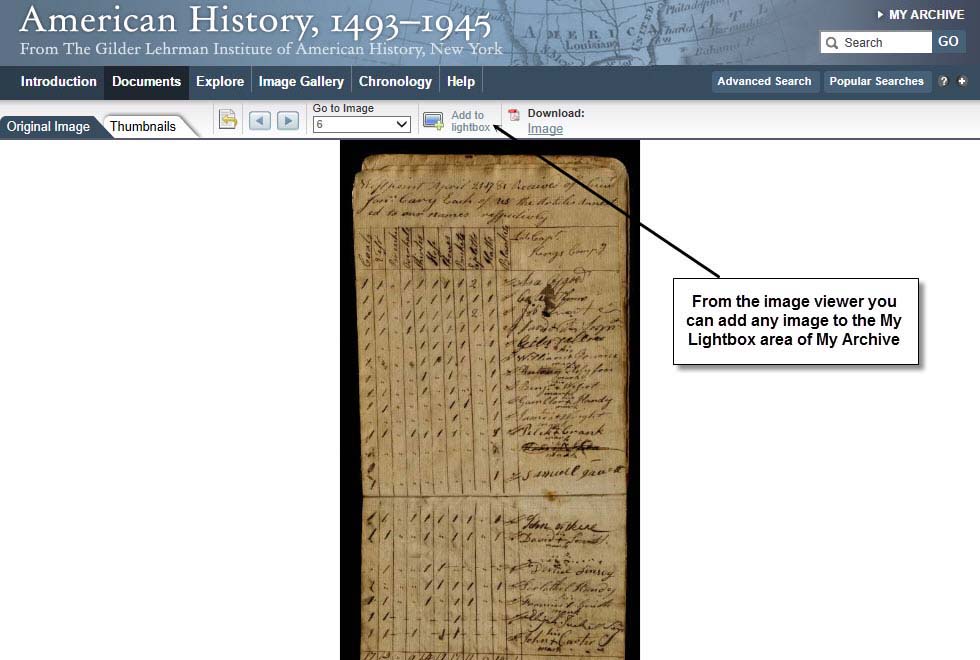
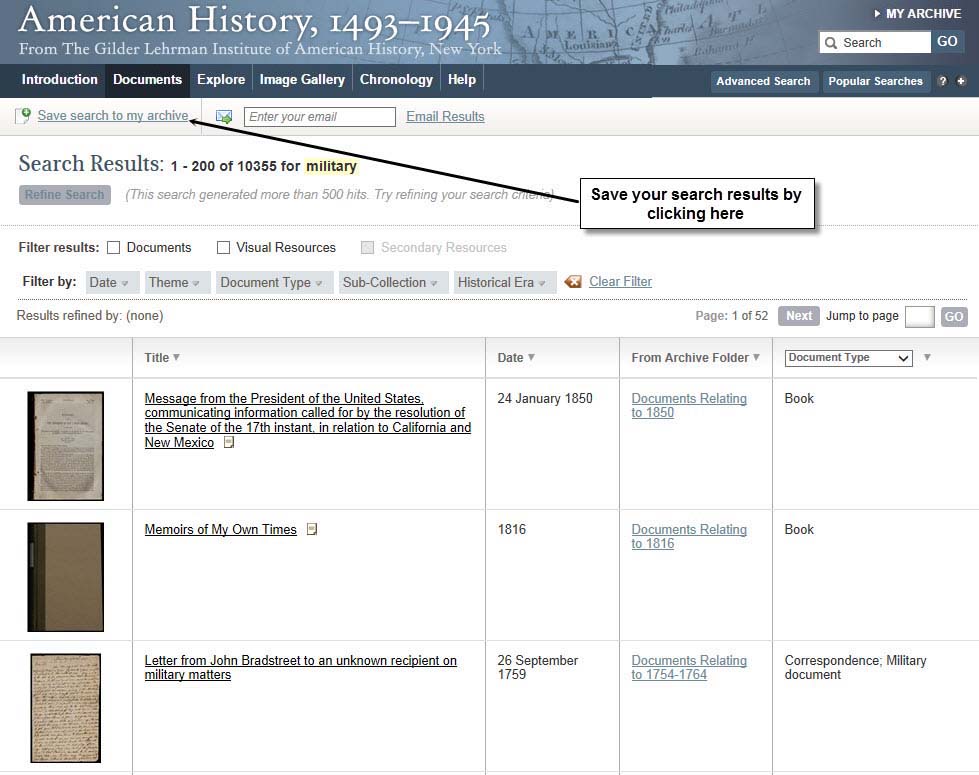
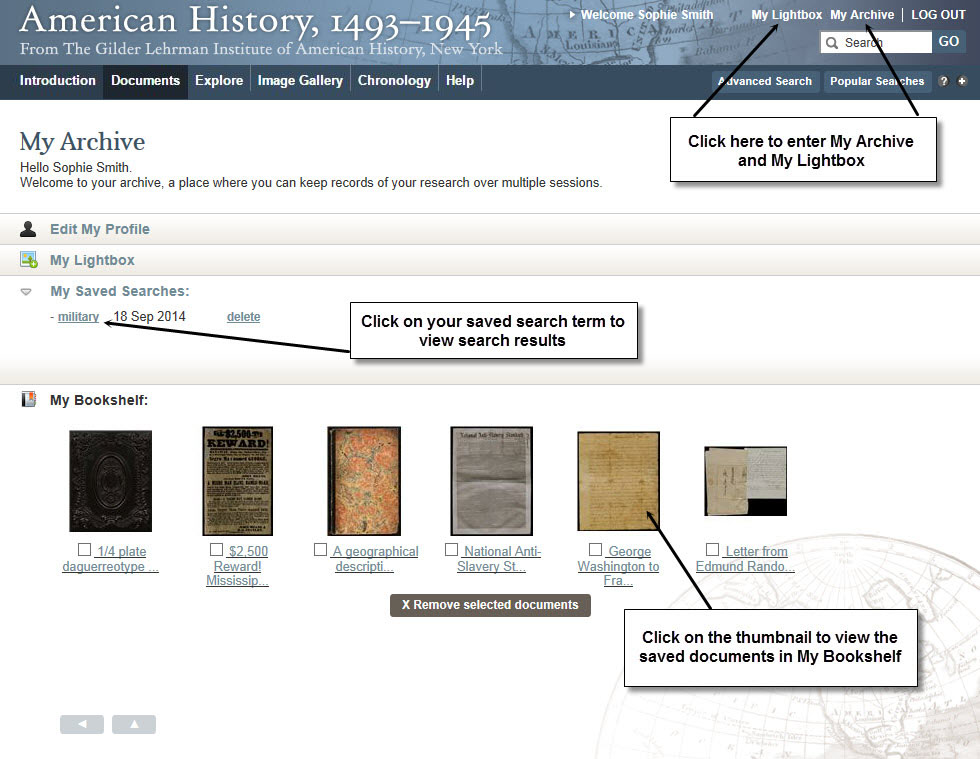
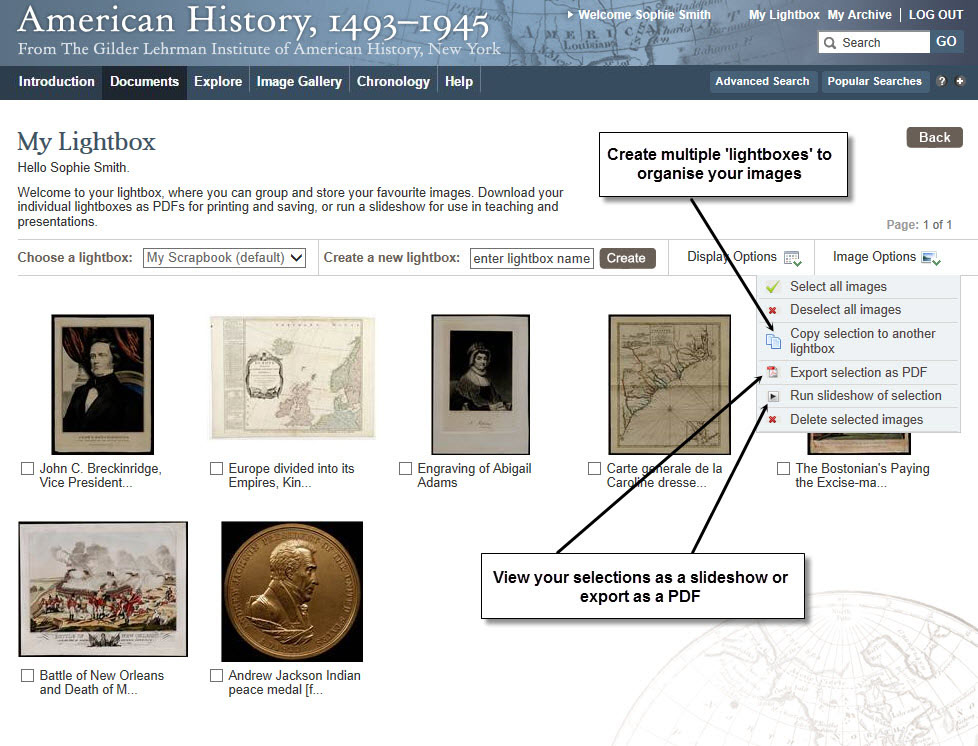
Documents
Overview and Browsing
Users can browse the documents in American History, 1493-1945 by clicking on the Documents tab.
Select some fields to browse by selection from the Date, Theme, Document Type or Sub-Collection.
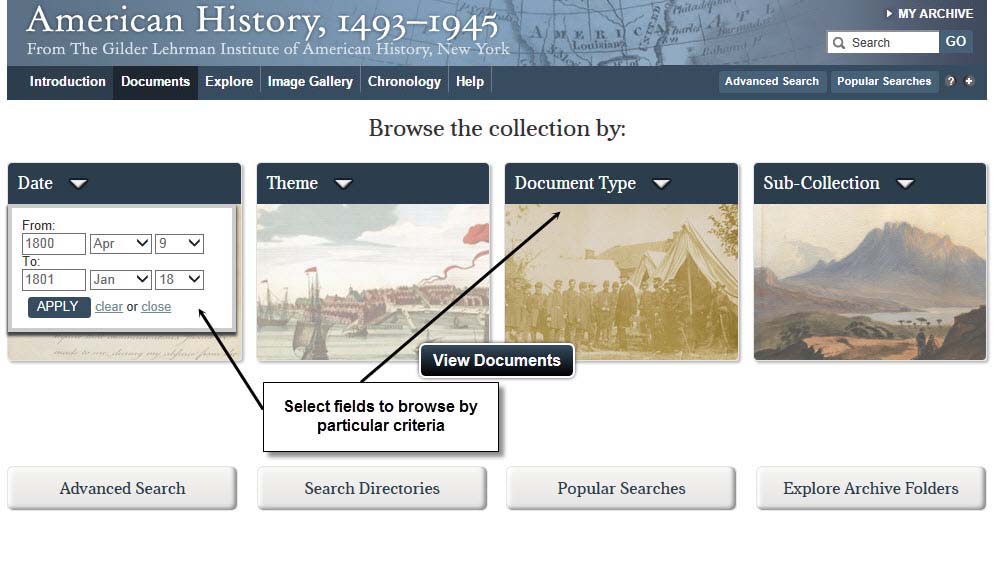
You can select different browsing criteria from the browse results page.
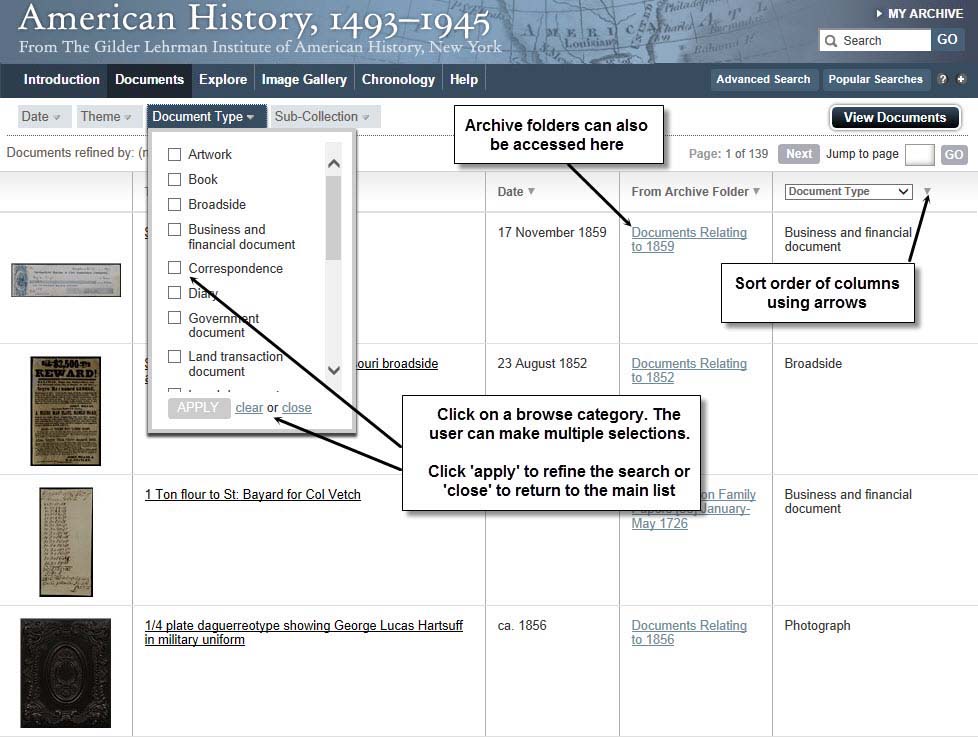
Navigation between pages with more than 200 documents listed is available at the top of the list. Users can browse previous and next pages or select a page number.
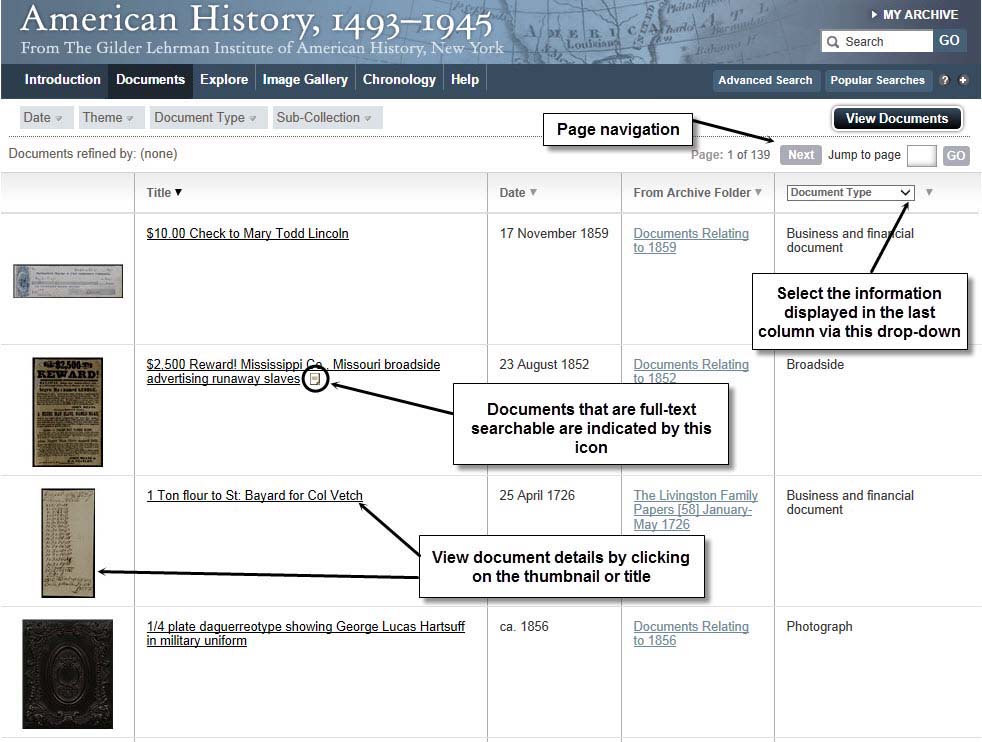
If you change your browse criteria – you can select multiple values in multiple categories – in a browse list of documents you will need to click on the View Documents button.
Full text searchable documents are indicated with the following icon ![]()
Once you are in the desired contents view page, click on any one of the title links and this will take you to the Document Details page that provides thumbnail images from the document, full bibliographic information, document-level indexing data and the ability to start viewing the original image or select some or all of the document to download.
You can also navigate to the other items in the document’s Archive Folder and return lists of documents that have the same author, recipient or subjects.
Where available, some additional Chapter or Section information, Transcripts and Visual Material metadata will be displayed.
From this page you can also add the document to My Archive and, if you have the user rights, you can export the bibliographic details of each document to RefWorks or EndNote citation software.
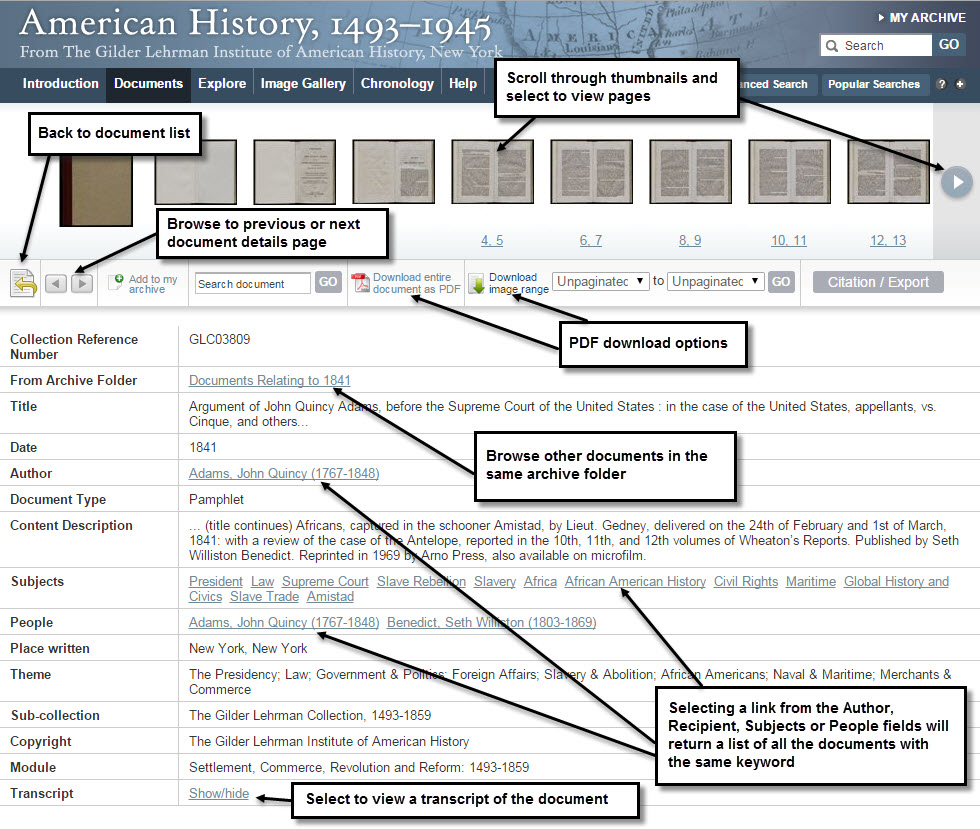
Download Options, Saving, Rotating and Printing
For the best-quality printout, it is recommended that you download the required image(s) as a PDF. Within the Document Details and the image-viewing pages you have several printing options. From the Document Details page you can download the entire contents of the document or specify a page or image range as a PDF document which can then be saved to file or printed. The image or page numbers available will be displayed in a drop-down box. Click on the required image/page to select the range to be downloaded.
When there is a page range provided there are sometimes a number of "unpaginated" images listed at the start of those available to download. These images can also be selected to download as each "unpaginated image" listed represents an image. For example, if there are six "unpaginated images" listed and you want to download them all, simply select the first image listed in the drop-down box and then select the sixth unpaginated image listed in the second drop-down box.
From the image view, you can download the current page you are viewing or, where available, specific chapters as a PDF document. Clicking on these options will open a new window for the PDF to download. Please bear in mind when downloading entire documents that many of the files will be quite large and can take some time. You will require Adobe Reader for this facility, which can be downloaded for free by clicking here.
Viewing the Original Image
Clicking on the thumbnail, title or a particular chapter will generate the image-viewing screen. The user can increase or decrease the magnification of the original image by using the ![]() or
or ![]() symbols at the top of the image-viewer window. To move around the image the user can drag the document by holding down the left mouse button and then moving the mouse to the preferred view.
symbols at the top of the image-viewer window. To move around the image the user can drag the document by holding down the left mouse button and then moving the mouse to the preferred view.
The ![]() icon will open the image viewer in full screen.
icon will open the image viewer in full screen.
The ![]() icon will rotate the image, which will resize to fit screen view.
icon will rotate the image, which will resize to fit screen view.
There are various ways to navigate through a document and you can also download images to print or save. Where available, some printed documents will have additional navigation features such as viewing full text transcription, jumping to the next chapter or selecting a specific page number.
Clicking on the Thumbnails tab will display all the thumbnails for the document.
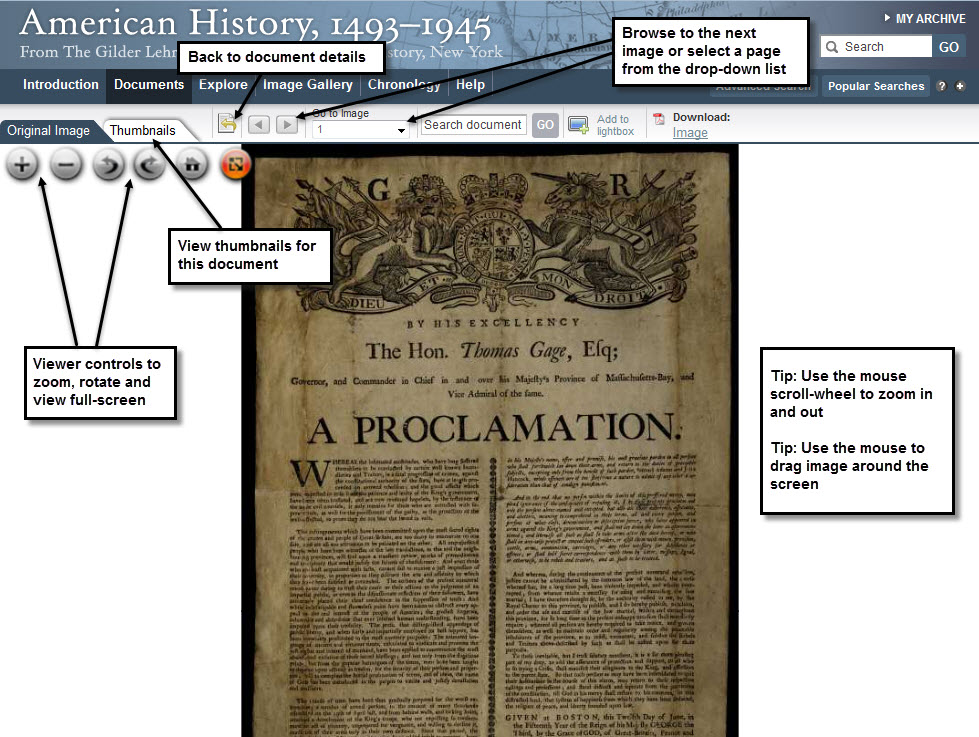
By clicking on the 'Bookmark & Share' button in the top right-hand corner of the page, users can bookmark and share the page they are viewing via a range of web-based resources and social-networking sites.
You can search the collection by its indexing. Each document in the collection is tagged with information such as author, recipient, subject, people and place written. The Search Directory allows you to browse these tags and then return lists of documents that feature these terms.
For example, if you want to see all of the documents that George Washington wrote, go to the Author Directory, navigate to ‘W’, select Washington, George (1732-1799) and then click the ‘Search’ button.
You are able to make multiple selections in each Directory.
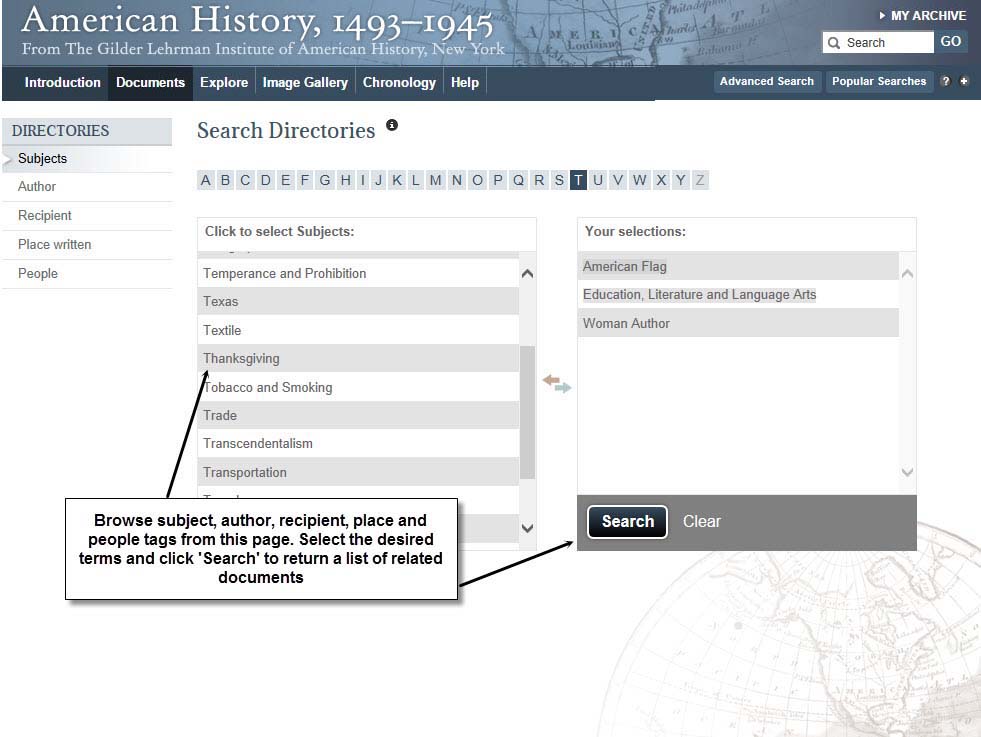
The Gilder Lehrman Collection in its physical archive form is often grouped by person, theme, event or date. This material is often housed in the same folder or box. We have recreated that archival structure in ‘Explore Archive Folders’. Here you can browse folders of material as you would find them in the archive.
For example, you can browse the folders and decide you are interested in ‘Collection of items relating to Presidential Pardons’. Make the selection – or select as many Folders as you wish – click ‘Search’ and you will be returned a list of items contained within that Folder or those Folders.
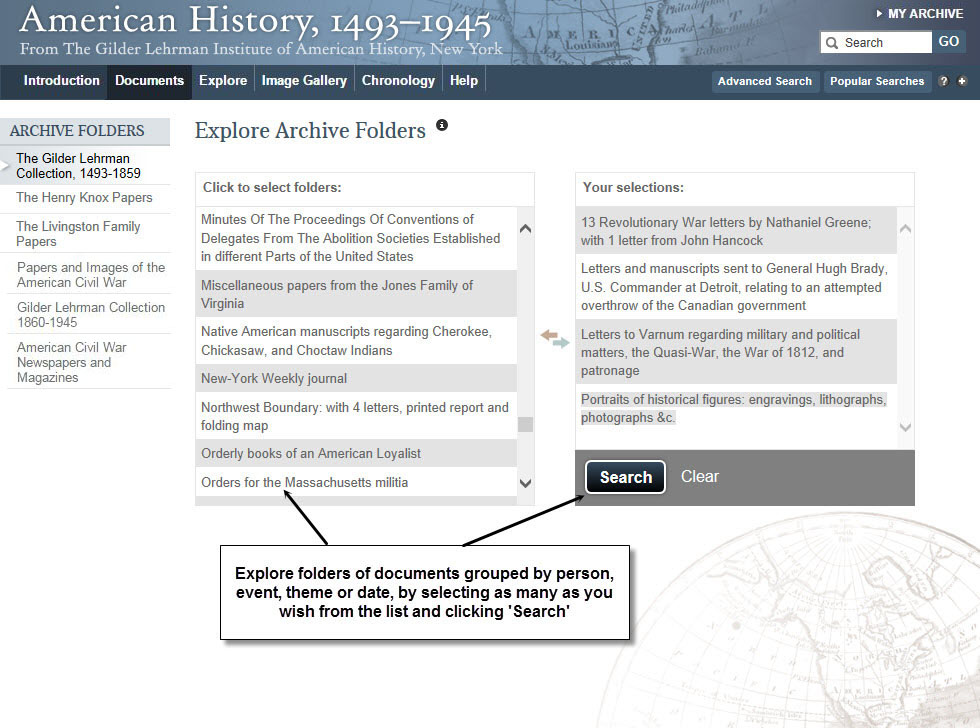
The search engine searches across all document-level metadata including bibliographic details, full text of printed material and selected additional editorial features.
Searches are carried out at document level for all documents and also at image level for full text search documents. Please note that a search for "Declaration AND Independence" will find hits at a document level i.e. where both appear on a page but also where Declaration appears on page 1 and Independence on page 100 of the same document.
Basic Search
A basic keyword search box is available on all screens in the top right-hand corner. Type in your search term and either click on 'Go' or press Enter. Users can also integrate their searches with Boolean text for more advanced queries. Underneath the basic search box are links to the Advanced Search option as well as a list of Popular Searches.
Boolean Operators
The keyword search supports the Boolean operators AND, OR and AND NOT between keywords. Using the terms Declaration and Independence as examples:
To return results in which both Declaration and Independence appear, use AND between terms (TIP: the search engine already does this by default - see section on Automatic AND Queries).
To return results which have either Declaration or Independence, add OR between terms.
To return results in which Declaration, but not Independence appears, add AND NOT between terms. This will search for Declaration but exclude any pages which also include Independence.
TIP: You can use either upper or lower case for Boolean terms.
Automatic AND Queries
By default, the search engine only returns results which contain all your keywords. The search engine automatically uses the AND operator, so there is no need to use this when searching for multiple terms.
TIP: To broaden or refine the keyword search, try using fewer or more terms.
Phrase Searching
By adding double quotation marks to your keywords you can search for exact phrases. Words enclosed in quotation marks (“House of Representatives”) will only return results in which the words appear next to each other. Please note that if you phrase search, your number of hits displayed will still appear as individual words (e.g. if the phrase “House of Representatives” appears on a page twice, the results will show six hits).
Wildcards
Wildcards allow you to search for parts of words, enabling you to widen your search criteria. The search engine supports two types of wildcards; "?" represents one character, and "*" represents any number of characters. For example, a search for "dem*" might retrieve "demonstrating", “democracy”, "democratic", etc. You can also use wildcards to search for words as part of a phrase.
Plurals
The search engine does not automatically find plurals of search terms. If you want to look for both book and books, use the Word Stemming option under the Advanced Search or the "*" wildcard.
Using Word Proximity Searches
The search engine will let you look for words or phrases that occur within a specified number of words of each other. This is a useful way of specifying the context in which words should occur. For example, a search for "Declaration w/5 Indepencence" may be a more accurate way of finding references to specific details than using a simple "AND" operator, but offers a broader net than that of a phrase search.
Word Stemming
By ticking the Word Stemming option on the Advanced Search page, you can command the search engine to return results on all derivations of your search word(s). Thus a stemming-enabled keyword search for "book" will return book, books, booked, etc. However, it will not return different words that simply begin with book (e.g. bookseller, bookkeeper). For this, you need to use a wildcard.
The Advanced Search page enables users to search for several keywords or phrases using the AND, OR and NOT Boolean operators. Extra fields can be added using the button.
TIP: Use of these drop-down operators still follows the Boolean rules of precedence.
A date-range restriction can also be entered. This can be used in conjunction with a keyword or other restricted searches, or across all documents by leaving the other fields blank.
Searches can also be restricted by theme.
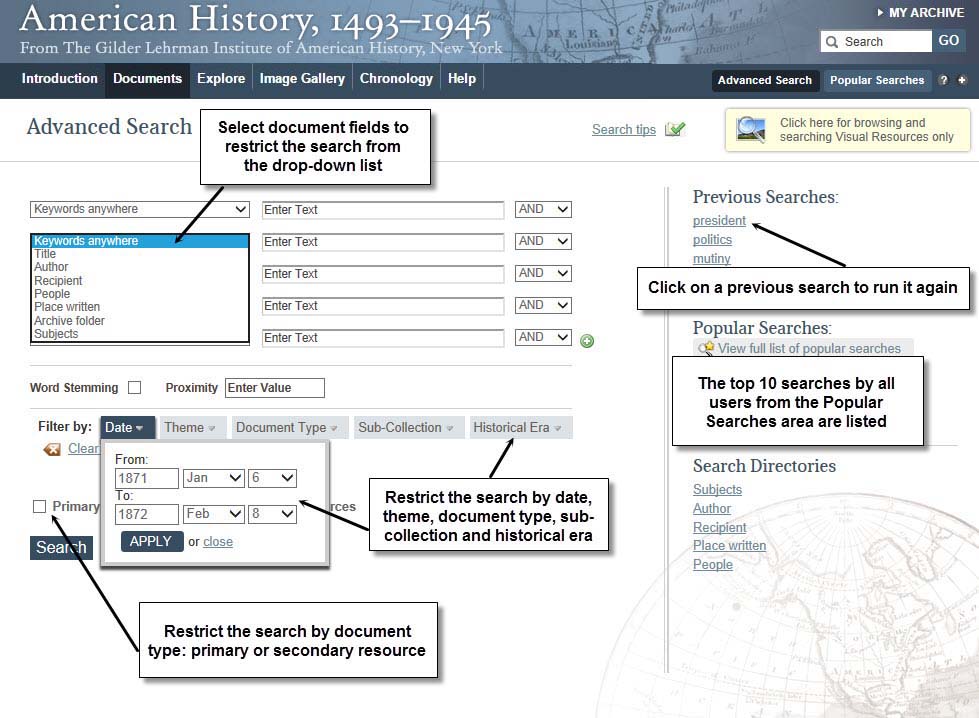
Popular and Top Searches
Please note that these lists are provided as a starting point for users and are not exhaustive of all metadata or the full text data.
The top 10 keywords that have been selected the most by users from the Popular Search lists are displayed in order of popularity on the Advanced Search page.
At the top of the search results page, the user can select to filter results by Primary documents only or refine via Collection or Document Type.
Users can export results as an email.
When the user selects a document from the search results list, they will be taken to the Document Details page, where further details of the result will be displayed.
Full text search results will be displayed with a list of the relevant sections from the original image with additional details of the image number, chapter number and number of hits where relevant.
These results can be reordered on the bases of relevance, pages or number of hits.
To view the full document metadata click on the 'Show All Metadata' button at the top of the page. If there is a hit from the document-level metadata, then this will be highlighted.
TIP: If the document is returned in the search results with no full text hits, the metadata will be opened automatically.
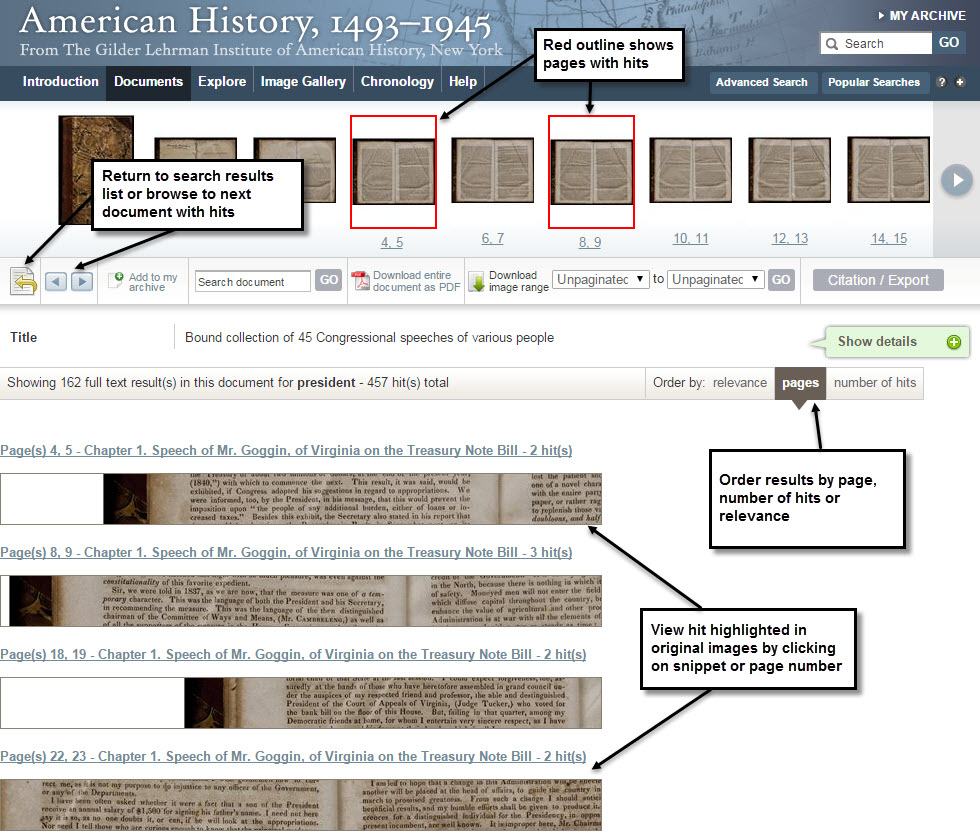
The user can view the relevant image from the full text search results by selecting the link above the original image snippet (see above). You can view the document from the beginning by clicking on the thumbnail image.
Full text hits are highlighted in yellow on the original image.
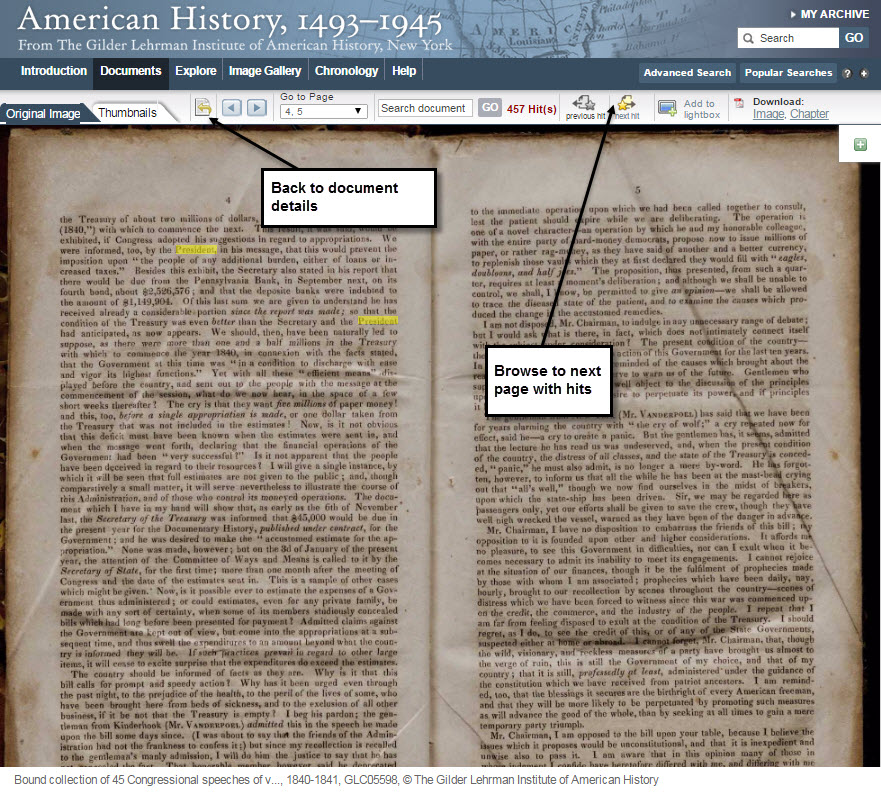
Selecting to view search results will open the relevant document in the relevant collection in a new window.
Visual Resources
Visual Galleries
Selected visual resources have been grouped together into visual galleries, which can be filtered by image type and theme using the drop-down lists.
To view a slideshow of images, select the images you want to use by clicking the tickbox next to each title, then select 'Run Slideshow of Selection' from the 'Open Image Options' drop-down. Alternatively, you can save the selection for this session (hover over the ‘Saved Selections’ option to retrieve), or download the selection as a multi-page PDF.
TIP: The order that you select your images in will be the order that they are played in the slideshow.
To view a full-size version of the image, click on it. You can browse through the images by clicking the 'Next' and 'Previous' buttons, or using the left and right arrows on your keyboard.
Metadata relating to the slideshow material can be searched in isolation via the Visual Resources Advanced Search page.
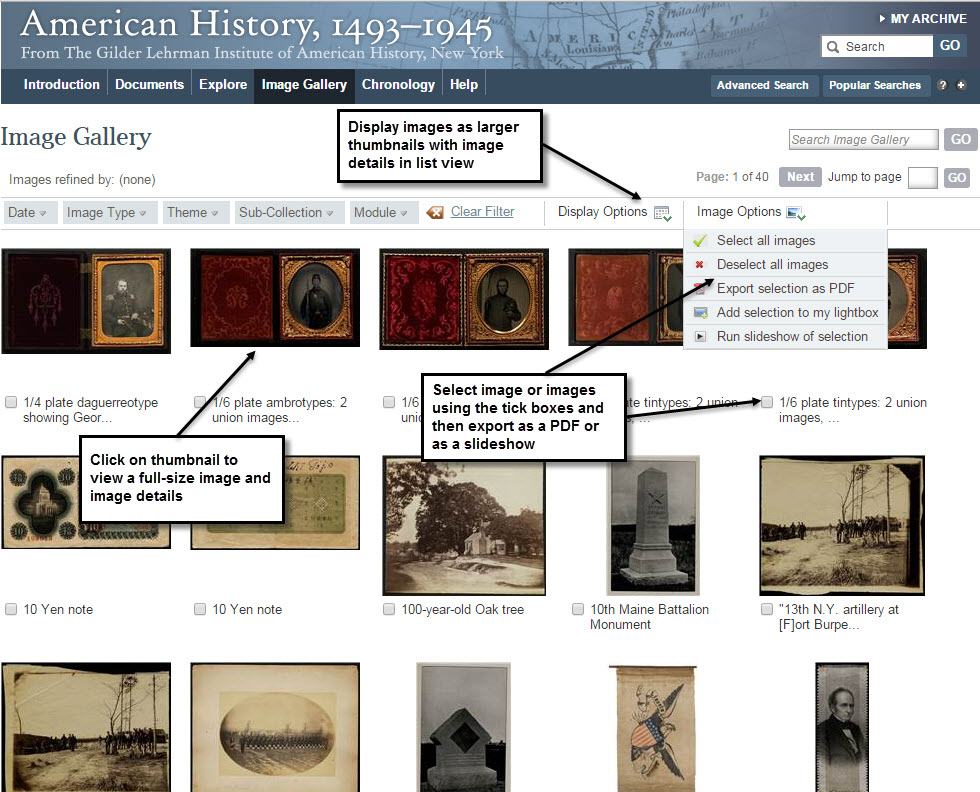
Chronology
The Chronology tab opens a powerful interactive chronology in a new window. Clicking on an entry enlarges the image and reveals further details, as well as giving the option to add the entry to List View and create a personalised chronology.
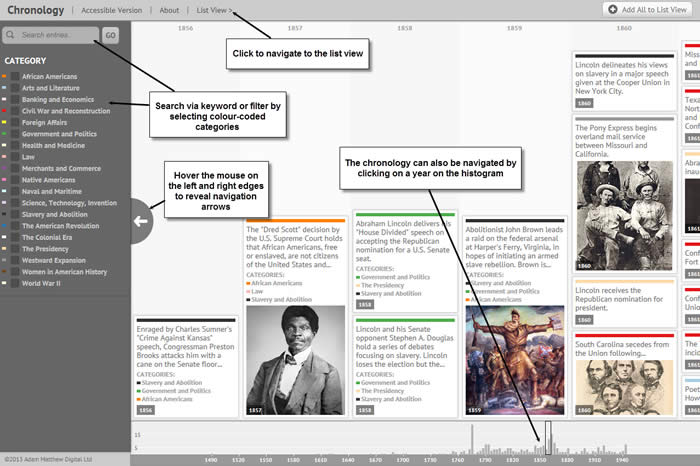
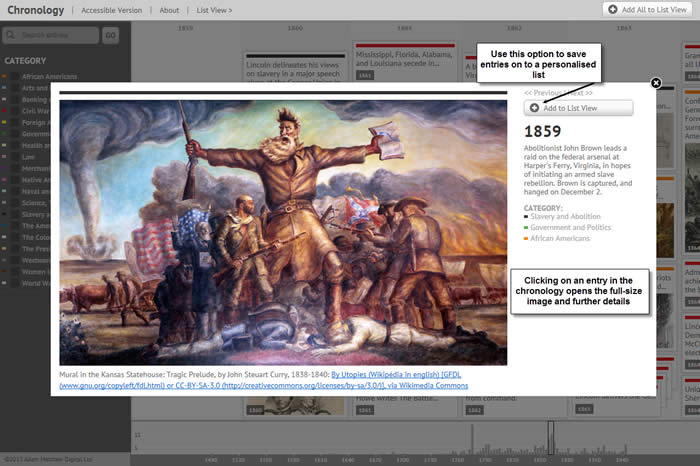
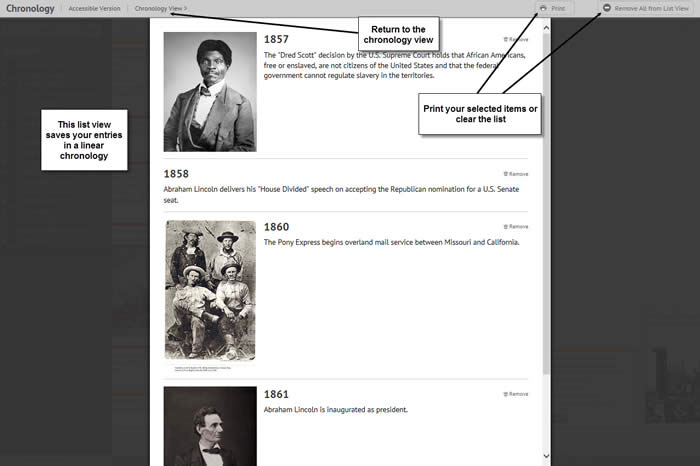
Mount Vernon and George Washington
This area features image slideshows and a text introducing George Washington’s family home, Mount Vernon.
The History of America in 100 Documents
This feature demonstrates some of the highlights and key themes of the Gilder Lehrman Collection. It can help you explore the collection more fully by linking through to some of the most important subjects in the collection.
This feature situates document and images from within the collection on an interactive map of the great Civil War battlefield of Gettysburg. See eyewitness accounts of key moments of the battle and historic and modern views of the battlefield.
Thematic Guides
This section explores several themes through the documents, containing links within the text to documents in the collection.
This section provides the user with a selection of essays written by leading academics.
TIP: The![]() icon will generate a printable version of the essay.
icon will generate a printable version of the essay.
TIP: The![]() icon will generate a PDF version.
icon will generate a PDF version.
By clicking on this option on the Further Resources home page, users are provided with a listing of websites with important and interesting material on American history studies, along with a brief overview. Click on the link next to the thumbnail image of each site and it will open in a new window. Please note that while every effort has been made to provide links to sites created by recognised institutions, Adam Matthew Group is not responsible for their content.
Archive Explorer is a federated searching tool that gives you a quick and convenient way to search across all Adam Matthew collections. You will only be able to access document collections that your library is subscribed to. A link to Archive Explorer is available on the footer of all pages and the Advanced Search page.
There is a link to the Popular Searches page beneath the basic search box, in the top-right corner of every page. Popular Searches provides a list of keywords and, when you click on an entry, it performs a search across the site for that term. The list is not exhaustive but is designed as a useful starting point for searches. Where possible we have automatically included alternative spellings for certain terms.
You can export the bibliographic details of each document to RefWorks and EndNote if you have user rights to these systems. These options are available to you on the document's listing or on the Document Details page of each individual item. Just click the RefWorks or EndNote logos, and a pop-up window with instructions will appear.
OpenURLs connect you directly to your library catalogue, allowing you to easily access material recommended on this site. You'll find OpenURLs on the essay pages, or anywhere we suggest you continue your research using library materials. Click on the reference to send this item to your institution’s link resolver and establish the easiest way to access this material that is not directly available on this site. Please note that your institution must have registered their link-resolver details with Adam Matthew Digital for the OpenURL links to be visible and active.



